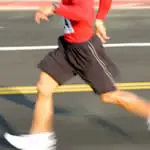Parkerson-Mitchell often finds the culprit is poor rotation of the hip joint during the gait cycle. "Imagine a new rubber band that is strong and supple. You can't fling that band across the room if you don't load or pull back on it," she says. "If you don't internally rotate your hip, the glutes will not be pulled into action and if the glutes don't do their job, then the hamstrings will come in to help and end up getting overworked."
More: How the Hamstrings, Hips and Glutes Power the Running Stride
Since there are other injuries that can occur in that same area, it is important to visit your doctor or physical therapist to get a diagnosis. A MRI is one way to do so, but a study published in the British Journal of Sports Medicine in 2012 also identified three simple tests to help clinicians determine if an athlete is dealing with hamstring tendinopathy. Basically, if a patient feels pain in the glutes or hamstrings when performing any of these exercises, HHT may be present:
- Standing, lift your leg and place your heel atop a waist-high platform with your leg straight. Stretch your body forward as if you are trying to touch your toes.
- Lying on your back, put one leg out straight and bring the other into the air. Start with that leg bent and then slowly have someone straighten it so the bottom of your foot eventually faces the ceiling.
- Similar to the last test, simply have someone straighten that leg in the air more quickly to see if rapid movement irritates the area.
More: How Athletes Can Fix 6 of the Most Common Form Deviations
Treatment Options for Hamstring Tendinopathy
To be sure, the longer you run around without treating HHT, the worse it'll get. This is why it is important to assess the damage and come up with a plan of attack for rehab. The first adjustment that is usually made is to a runner's training regimen. While some can continue running through treatment, speed work and other high intensity sessions should be eliminated until the pain subsides.
In more acute cases, a total running layoff may be required, along with anti-inflammatories and ice.
"Treatment will depend upon the underlying cause, but usually entails a combination of manual treatment and functional strengthening," says Parkerson-Mitchell. This would include therapies such as Active Release Technique and deep tissue massage.
More: Massage for Runners: The Low-Down
"Once the condition is chronic, treatment focuses on remodeling of the tendon through eccentric strengthening, lumbopelvic stabilization and hamstring strengthening," says Rhodes.
Through gait analysis and a number of other tests, imbalances in the pelvis and lower extremities can help identify the cause of the injury and determine the best plan for rehabilitation.
More: What Is Gait Analysis?
"Stretching, activity modification and manual therapy are important, but long-term success is not possible without functional strengthening of weak tissues," says Parkerson-Mitchell.
While no one likes to be injured, symptoms of HHT may be the canary in the coalmine, signaling something else is going haywire in your kinetic chain. Be sure to listen to your body and respond when it's telling you to back off. By identifying the root cause of HHT symptoms early on, you may save yourself from a long list of other injuries down the road.
More: How to Prevent Running Injuries in 2 Easy Steps
 Sign up for your next race.
Sign up for your next race.- 2
- of
- 2
About the Author

Get ACTIVE on the Go


Couch to 5K®
The best way to get new runners off the couch and across the finish line of their first 5K.
Available for iOS | Android








Discuss This Article